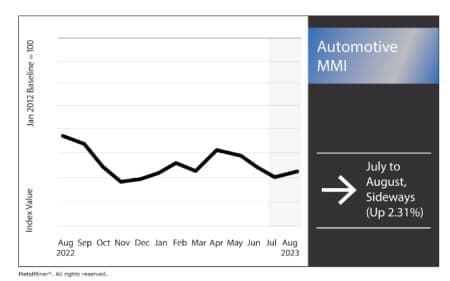Via Metal Miner
Compared to other metal industries, components of the automotive industry still remain somewhat strong, despite the Automotive MMI (Monthly Metal Index’s) sideways movement over the past seven months. Pent-up consumer demand still runs strong in the industry. However, it still continues to battle high interest rates and falling steel prices due to slumping demand. There could potentially be a swing to the upside in the long-term should the Fed begin lowering interest rates. However, most experts don’t anticipate that will happen until at least 2024. Until the Fed goes dovish, the index could remain somewhat sideways. All-in-all, the Automotive MMI moved sideways, rising up by 2.31%.

Semiconductor Shortage Still a Problem With no End in Sight
The ongoing microchip shortage is significantly impacting the automobile sector in the U.S., particularly in the production of electric cars (EVs). Automakers have faced shortened production schedules and suffered huge financial losses since the chip shortage began. The scarcity is projected to result in cutting 2.8 million global vehicles for the year 2023, a stunning figure that highlights the seriousness of the crisis. Chip scarcity has been a significant impediment for organizations in numerous industries, with automakers being among the most affected.
While consumer electronics manufacturers account for approximately 50% of microchip supply, automakers account for approximately 15% of supply. As passenger vehicles become more technologically advanced, they continue to rely more and more on microchips.
Despite the global chip scarcity, more manufacturers are prepared to cut prices in order to qualify for the EV tax credit. This may end up making EVs more affordable. However, buyers may have to wait for some time before they can purchase brand-new EVs at a more affordable rate. Due to the continued chip shortage, automakers will eliminate about 18 million vehicles from production plans by the end of 2023. According to Ford’s Chief Financial Officer, John Lawler, “there is still going to be volatility around chips” in 2023. “It’s easing,” said Sam Fiorani, Auto Forecast Solutions’ vice president of global vehicle forecasting. “There are more chips out there, and if you have proper access to them, your production will be fine.”
Sideways Steel Prices Could Aid Automotive Industry
Steel prices still currently find themselves in a sideways market, with prices only recently beginning to witness more movement. Sideways movement in steel prices can benefit the automotive sector in the following ways:
- Limited steel price volatility helps automakers to have more predictable and steady costs for steel inputs. This pricing stability aids them in planning and budgeting for their manufacturing processes and overall operations.
- Steel price stability allows automakers to offer competitive pricing for their vehicles. When steel prices are variable or rising, automakers may be forced to pass on the greater costs to customers, resulting in higher vehicle pricing. However, if steel prices remain stable, automakers may keep their vehicle prices low, luring more buyers.
- Stable steel prices support a steady supply of steel for the car sector. Automakers can ensure a consistent supply of steel with predictable prices, assuring continued manufacturing.
Negative Implications of Sideways Steel Prices on The Automotive Industry
Any major changes or sideways movement in steel pricing, on the other hand, can have a detrimental influence on the automotive sector. If steel prices break out of their sideways trend, the automotive market could experience the following:
- When steel prices fall or rise, automakers must endure higher costs for procuring steel, which can eat into profit margins.
- Sudden changes in steel prices can result in automakers facing higher production costs, leading to lower profit margins. If steel prices remain high or rise while other expenses remain unchanged, automakers may struggle to sustain profitability.
- When steel prices rise, automakers may pass the increased costs on to customers in the form of higher vehicle pricing. This action may make vehicles less affordable to prospective customers, resulting in a drop in demand for new vehicles.
- Rising steel prices may lead automakers to pass on extra expenses to customers in the form of increased vehicle prices. This could make vehicles less affordable to prospective customers, resulting in a drop in demand for new vehicles.
It should be noted that these negative consequences may not be instantaneous or universal across the whole automotive industry. The magnitude of the impact varies based on factors such as the magnitude of steel price swings, market conditions, and individual automakers’ tactics for mitigating the consequences of steel price movements.
By Jennifer Kary
More Top Reads From Oilprice.com:
- From Unknown To Unstoppable: New Traders Redefine Russia's Oil Landscape
- America's Credit Downgrade: A Sign Of The Times Or Tip Of The Iceberg?
- Glencore Combats Profit Plunge With Buyback Boost


















